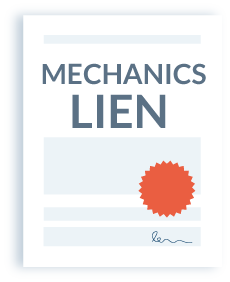
A mechanics lien is an incredibly powerful remedy for nonpayment in the construction industry. However, a mechanics lien isn’t just a piece of paper, but rather an entire process. Each step and requirement must be met in order to secure the right to lien. But getting that piece of paper filled out properly can make or break your mechanics lien claim. One issue that constantly arises is how to correctly fill out your lien claim form. Especially when it comes to how much detail is necessary for the description of labor and materials provided to the project.
Mechanics liens can be rejected by a county recorder office for a number of reasons. Whether it be late filing, providing the wrong filing fees, or failure to provide required additional documentation, the details can get overwhelming. One of the most common reasons mechanics liens are rejected is an insufficient description of labor and materials. In fact, that question routinely pops up from our customers, “How detailed does my description of work need to be on my lien?”
Why is a description of labor & materials even required?
What’s the point? Well, legally speaking, mechanics liens are meant as a way to get around the requirement of privity of contract. This is a fundamental doctrine of contract law. It states that a person cannot enforce contract terms against someone who wasn’t part of that contract. Given the payment structure on a construction project, the nonpayment can potentially be caused by someone other than whom a claimant has contracted with.
Cue the mechanics lien, which places liability on the owner through an interest in their property. The issue is that an owner can potentially be completely unaware of the claimant’s presence on the project, let alone the contract terms. The mechanics lien claim needs to be able to identify what labor and materials the claimant provided. After all, that’s what forms the basis of their claim. This is why most states require a description of labor and materials provided, as a way to verify that the claimant contributed value to the improvement of the property.
Description of labor and materials requirement
There are a number of states that require some sort of “general statement of the labor or materials provided.” Yet rarely do these statutes provide any more guidance on what is actually required. Since the filing of a lien is time-sensitive, having the claim rejected, for any reason, can potentially result in missing a deadline and losing your lien rights.
State requirements
As mentioned above, states such as Florida, California, Texas, and New York, to name a few, require a general statement of labor performed or materials furnished.” The law and courts in some of these states have provided a little guidance on what constitutes a sufficient description. However, some statutes and court decisions have clarified this a bit.
In Florida, mechanics lien statute touches on this matter. Fla. Stat. §713.08 even states that “the omission of any of the foregoing details or errors in such claim of lien shall not, within the discretion of the trial court, prevent the enforcement of such lien as against one who has not been adversely affected by such omission or error.”
Similarly, in New York, the court in In Matter of Superior Maintenance Group declared that what is required is some description (something more than simply “labor and materials were provided”) sufficient to apprise the owner and all interested parties of the nature of the material and labor for which the lien is claimed. –
Some states that require a description of labor and materials, and then take it even a step further. These states require additional evidence or documentation to support the description of labor and materials. For instance, in Arizona, in order to be filed and recorded, the lien claim should include a copy of the written contract, or a general statement of the terms and conditions if the contract is oral. The same goes for states like New Mexico, Arkansas, Pennsylvania, and Wyoming.
Real-world examples
We here at Levelset consider ourselves the mechanics lien experts. We’ve helped contractors and suppliers file thousands of mechanics liens a year, in nearly every state. We’ve seen it all. Here are a few examples of good and bad descriptions of labor that our team has come across recently:
Rejected descriptions
- Electrical work
- Roofing supplies
- Installed product and material
- Sold flooring and cabinets to this customer and also installed them to the mentioned address
Accepted descriptions
- Our company was hired to replace roof due to storm related damage. The materials included 34 squares of shingles, 15 lbs of felt paper, 3 pcs of OSB board decking, pipe boots, (and so on). The labor included removing old shingle, felt paper, removal of retten and damaged OSB boards, clean up, and labor associated with the total installation process of materials to replace the roof.
- Metal refinishing cleaning and applying a chemical patina process to the bronze show window panels and exterior store front window frames. Cleaning materials, patina chemicals, and lacquer.
- Interior: remove wallpaper in kitchen, laundry,3 bedrooms.hall. Sheetrock repairs in Master bath, repairs all 3 bedroom windows for mildew in window returns, sheetrock repair in hall closet, tape and float sheetrock in laundry, repair sheetrock under ventahood in kitchen. sheetrock repair in hall entry which was raw with no sheetrock at all, both sides with texture. Prime and paint 2 bedrooms and hall, paint 1 bedroom. Prime and paint kitchen, and laundry room. Paint front and back doors, paint all casings in home, prime and paint 90% of baseboards in home. Painted kitchen ceiling, laundry ceiling, 3 closets and both bathroom ceilings. Provided all paint and supplies for this project, 5 gallons of primer, 8 gallons of Behr paint, 2 gallons of sheetrock mud, sheetrock tape fiberglass, sheetrock patch kits 2, texture cans 2.
As you can see, the devil is in the details. A full itemized list isn’t necessarily required, but the more information you provide the better. No one’s mechanics lien has been rejected for providing too much information!
County recorder vs. Courtroom
I feel it’s important to make a distinction here. There is a difference between a description that’s acceptable for filing with a county recorder and a description that is acceptable in a courtroom during a foreclosure action.
County recorder office
Dealing with a county recorder’s office can prove, difficult at best. The issue is the evaluation of the description of labor or materials is incredibly subjective. A description that’s acceptable in one instance can end up being rejected in the next. It all depends on the recorder. Which doesn’t seem right, does it?
County recorders are meant to do just that… record. There is no reason a county employee should be making legal determinations. Particularly, ones that can seriously affect a person’s mechanics lien rights. Yet, this is an issue that happens over and over again. Sadly, the recorder or clerk’s office is an indispensable cog in the mechanics lien machine. So, unfortunately, the recording of your claim is in their hands. Flood them with information, so you leave them with no excuse to deny your claim.
Now that that’s out of the way, the more important question should be whether the description of labor and materials is sufficient for the foreclosure of the lien. Mechanics liens are created by statute, which means that they need to comply with the statutory requirements as close as possible in order to be valid and enforceable.
Enforcement action
If the lien claim ends ultimately ends up in court, be prepared. Judges and opposing attorneys alike can tend to get petty quickly. They will look for any reason to invalidate the lien claim. This can range from an insufficient description of labor and materials to something as minor as a typographical error in providing their name.
However, challenging the description of labor and materials in court may not effectively invalidate the claim. The message from a number of cases from different jurisdictions seems clear. The determining factor is whether the description has an adverse or prejudicial effect on the property owner. Here are two examples.
California case “where the purpose of the requirement of the statute is achieved, and no one is prejudiced, technical requirements will not stand in the way of achieving the purpose of the Mechanics Lien Law.” –Wand Corp. v. San Gabriel Valley Lumber Co.
Texas case: “courts that have addressed substantial compliance issues have distinguished between mere technical defects, which can be excused, and those defects that are more substantive in nature and, if overlooked, would read a provision out of the statute or prejudice another party.” –First National Bank in Graham v. Sledge
It stands to reason that an error in the description of labor and materials won’t necessarily be fatal to your lien claim. As long as the description doesn’t have some sort of negative or adverse impact on the other party, the deficiencies will most likely be overlooked. Although many statutes are strictly construed, at the end of the day, the mechanics lien laws are meant to secure payment on a construction project. Minor discrepancies or good faith errors won’t likely be enough to defeat a valid claim in court.
Best practices
Although liens can be rejected for not providing enough information, there is never a penalty for adding too much information. As you can tell from the examples above, the prevailing theme is the more details provided, the more likely the description of labor and materials will be sufficient.
Another good practice to adopt is just to include copies of invoices or the contract itself with your lien filing. Most counties will accept attachments, even if they’re not required. But keep in mind, that most county recorder offices charge by the page. Depending on the contract price, spending the extra dough to file your contract or invoices may be worth it in the long run. This is particularly true if the claim finds it’s way into court.
Last piece of advice, file as early as possible. If your lien is rejected by the recorder’s office, be sure to leave yourself ample time to correct the mistakes and refile.
Additional resources
- 4 Essential Questions to Ask Your County Recorder
- 4 Worst Mechanics Lien Mistakes Made by Contractors and Suppliers
- How to File a Mechanics Lien – Step by Step Guide to Any State




